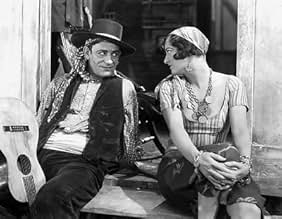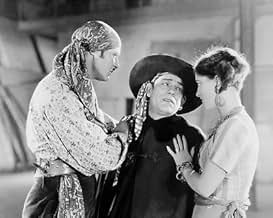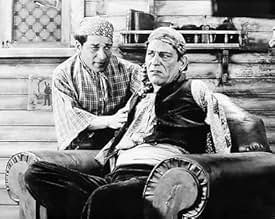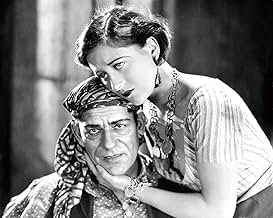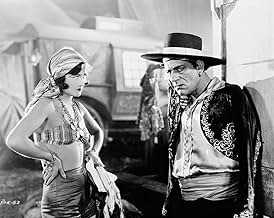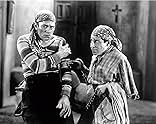CALIFICACIÓN DE IMDb
7.7/10
9.9 k
TU CALIFICACIÓN
Un criminal prófugo se oculta en un circo y busca ganarse el corazón de la hija del jefe a toda costa.Un criminal prófugo se oculta en un circo y busca ganarse el corazón de la hija del jefe a toda costa.Un criminal prófugo se oculta en un circo y busca ganarse el corazón de la hija del jefe a toda costa.
- Dirección
- Guionistas
- Elenco
- Premios
- 2 premios ganados y 2 nominaciones en total
Tom Amandares
- Gypsy running to Zanzis Death Scene
- (sin créditos)
Margaret Bert
- Fortune Teller
- (sin créditos)
Louise Emmons
- Gypsy Woman
- (sin créditos)
Italia Frandi
- Girl in Audience Flirting with Malabar
- (sin créditos)
Venezia Frandi
- Woman in Audience
- (sin créditos)
Polly Moran
- Landlady
- (sin créditos)
- …
Julian Rivero
- Man in Theatre Audience
- (sin créditos)
Billy Seay
- The Little Wolf
- (sin créditos)
Dorothy Seay
- Spectator
- (sin créditos)
John St. Polis
- Surgeon
- (sin créditos)
- Dirección
- Guionistas
- Todo el elenco y el equipo
- Producción, taquilla y más en IMDbPro
Opiniones destacadas
A circus performer ventures into THE UNKNOWN regions of fate when he allows love to be twisted by hatred.
Master actor Lon Chaney and his friend, acclaimed director Tod Browning, took their love of the macabre and fashioned this weirdly entertaining & suspenseful little silent film, made wonderful by Chaney's powerful over-the-top performance. Playing the armless wonder in a gypsy circus, Chaney's face is a casebook of emotions as he longs for the chieftain's daughter. After making a tremendous, indeed, outrageous, sacrifice for her, he discovers it is all an utter waste. Chaney's agony is horribly apparent as he feels his life crumble around him. The actor uses his superb physical conditioning to great effect, his feet as facile as any hands--the extreme punishment undergone to play the part enormously impressive.
In an important early film role, Joan Crawford is both sultry & disarming as the object of Chaney's desires; her intense neurotic phobia concerning men's hands certainly makes her character more interesting. Norman Kerry is affable & tender as the circus strong man who also loves Crawford. John George as Chaney's dwarf accomplice and Nick De Ruiz as the brutal circus chief are quite effective in their colorful roles.
MGM gave the film fine production values, especially in the circus scenes--a milieu dear to Chaney's heart.
Master actor Lon Chaney and his friend, acclaimed director Tod Browning, took their love of the macabre and fashioned this weirdly entertaining & suspenseful little silent film, made wonderful by Chaney's powerful over-the-top performance. Playing the armless wonder in a gypsy circus, Chaney's face is a casebook of emotions as he longs for the chieftain's daughter. After making a tremendous, indeed, outrageous, sacrifice for her, he discovers it is all an utter waste. Chaney's agony is horribly apparent as he feels his life crumble around him. The actor uses his superb physical conditioning to great effect, his feet as facile as any hands--the extreme punishment undergone to play the part enormously impressive.
In an important early film role, Joan Crawford is both sultry & disarming as the object of Chaney's desires; her intense neurotic phobia concerning men's hands certainly makes her character more interesting. Norman Kerry is affable & tender as the circus strong man who also loves Crawford. John George as Chaney's dwarf accomplice and Nick De Ruiz as the brutal circus chief are quite effective in their colorful roles.
MGM gave the film fine production values, especially in the circus scenes--a milieu dear to Chaney's heart.
I've heard so much about this movie, and it was not a disappointment. The surviving print seems to be missing some scenes, which accounts for its short length, but I doubt it takes away much from this twisted, sadistic "Gift of the Magi" gone bad. Chaney's performance is remarkable and, at times, genuinely alarming, and the very young Joan Crawford is a typical, but nevertheless appealing silent film heroine. Parts of this film really had me squirming, particularly towards the end. Browning's visual sense is the most beautiful I've seen in any of his films other than Dracula, with a full range of greys, whites and blacks and painterly compositions. It's available on TCM's excellent Lon Chaney Collection DVD.
This movie survives with about ten minutes missing, mainly the story of Alonzo (Lon Chaney) the criminal before he hides at a circus as "Alonzo The Armless" where he uses his feet to accurately throw knives at Nanon (Joan Crawford) without hitting her. He has his actual arms strapped to his sides, making himself appear armless, thus deceiving all except his confederate Cojo, who helps Alonzo in and out of his restraining outfit at night. Alonzo involves himself in this elaborate subterfuge because he is known to have two thumbs on one hand. If that hand was seen he'd be instantly identified as the murderer that he is. He falls in love with Nanon, and she conveniently can't stand to have a man's arms around her. She feels safe around Alonzo because of his "armless" state, and only considers Alonzo a friend, but then he has never disclosed his feelings to her.
When the circus strongman, Malabar, falls in love with Nanon, suddenly Alonzo has a competitor. One day, alone in his room, ruminating over the possibility that he could lose Nanon to the strongman, Alonzo absent mindedly lights a cigarette with his feet, even with his hands freed. Suddenly, Alonzo comes up with a horrible solution to his dilemma, one that would allow him to marry Nanon and not be forced to disclose his true identity.
So many unknowns, some likely explained in the missing footage. Where did Cojo, the dwarf, who assists Alonzo come from? Was he an accomplice in Alonzo's past crimes? Why does he stick around? Why did Nanon fear having a man's hands on her? How is it that Alonzo conveniently knows the criminal past of a talented surgeon who can give him what he wants? And, most importantly of all, why didn't Alonzo just have that double thumb amputated in the beginning rather than get involved in this complex plan that culminates in such a rash solution? I guess because we'd have no movie.
Even in its abbreviated state, this early example of body horror is worthwhile and completely creepy. Plus I've found that anything Lon Chaney stars in is interesting. Joan Crawford is only third billed at this point, with Norman Kerry as Malabar getting second billing. Kerry was one of the many casualties of the transition to sound film due to his thick accent.
When the circus strongman, Malabar, falls in love with Nanon, suddenly Alonzo has a competitor. One day, alone in his room, ruminating over the possibility that he could lose Nanon to the strongman, Alonzo absent mindedly lights a cigarette with his feet, even with his hands freed. Suddenly, Alonzo comes up with a horrible solution to his dilemma, one that would allow him to marry Nanon and not be forced to disclose his true identity.
So many unknowns, some likely explained in the missing footage. Where did Cojo, the dwarf, who assists Alonzo come from? Was he an accomplice in Alonzo's past crimes? Why does he stick around? Why did Nanon fear having a man's hands on her? How is it that Alonzo conveniently knows the criminal past of a talented surgeon who can give him what he wants? And, most importantly of all, why didn't Alonzo just have that double thumb amputated in the beginning rather than get involved in this complex plan that culminates in such a rash solution? I guess because we'd have no movie.
Even in its abbreviated state, this early example of body horror is worthwhile and completely creepy. Plus I've found that anything Lon Chaney stars in is interesting. Joan Crawford is only third billed at this point, with Norman Kerry as Malabar getting second billing. Kerry was one of the many casualties of the transition to sound film due to his thick accent.
The Unknown (1927)
We can see The Unknown today and say, wow, look at the young Joan Crawford. And she does help make this movie come alive, more than even Lon Chaney, who was the big draw for audiences in 1927. Crawford's spark (inspired by Chaney, by her own account), and her character's phobia of men's hands (which she explains quite reasonably, having been groped too many times against her will) make her curious and very sympathetic. She's terrific to watch, and the metaphor of abuse against women is not lost on anyone paying attention.
But Crawford was essentially unknown back then, and the movie depended on the name, and the high dramatics, of Chaney and the other lead male, the charming, somewhat overly chipper strong man in this huge sideshow of a movie. Both are good enough in their roles, Chaney pulling out all the stops in a performance that might be bravura or might just be virtuosic indulgence, probably a bit of both.
And the movie depends on the story itself, the plot, the strange and gruesome series of events, which are gripping at times even if you know what's coming all too well. For viewers then as much as now, there is also the whole milieu, director Tod Browning's leaning to the macabre and the small time circus. This will see a more amazing fruition five years alter in Freaks, shortly after his very successful Dracula (with its self-sustaining sideshow of bizarre, legendary types). But here we have Browning at the end of the silent era, pushing gestures and expressions outward in the place of sound. It's a bit strained, and with the sensational plot, the whole movie lacks subtlety and depth.
What it doesn't lack is high drama, though, and a few surprises. At times touching, at times simply shocking (in its own way), it's enjoyable, and never really flags, which some "better" silent films like Broken Blossoms can't claim. So forget beauty, or elegance or emotional insight and you might really like this.
Oh, and Chaney? He is a marvel of his time, and this film shows him in one of his best roles as an actor, one of many. The armless man is yet another echo of the horrors of mutilated soldiers coming home from World War I and their inability to really assimilate and be accepted. The fact that his character is obsessed with Crawford's we might understand, but it's a love that we don't sympathize with after awhile.
We can see The Unknown today and say, wow, look at the young Joan Crawford. And she does help make this movie come alive, more than even Lon Chaney, who was the big draw for audiences in 1927. Crawford's spark (inspired by Chaney, by her own account), and her character's phobia of men's hands (which she explains quite reasonably, having been groped too many times against her will) make her curious and very sympathetic. She's terrific to watch, and the metaphor of abuse against women is not lost on anyone paying attention.
But Crawford was essentially unknown back then, and the movie depended on the name, and the high dramatics, of Chaney and the other lead male, the charming, somewhat overly chipper strong man in this huge sideshow of a movie. Both are good enough in their roles, Chaney pulling out all the stops in a performance that might be bravura or might just be virtuosic indulgence, probably a bit of both.
And the movie depends on the story itself, the plot, the strange and gruesome series of events, which are gripping at times even if you know what's coming all too well. For viewers then as much as now, there is also the whole milieu, director Tod Browning's leaning to the macabre and the small time circus. This will see a more amazing fruition five years alter in Freaks, shortly after his very successful Dracula (with its self-sustaining sideshow of bizarre, legendary types). But here we have Browning at the end of the silent era, pushing gestures and expressions outward in the place of sound. It's a bit strained, and with the sensational plot, the whole movie lacks subtlety and depth.
What it doesn't lack is high drama, though, and a few surprises. At times touching, at times simply shocking (in its own way), it's enjoyable, and never really flags, which some "better" silent films like Broken Blossoms can't claim. So forget beauty, or elegance or emotional insight and you might really like this.
Oh, and Chaney? He is a marvel of his time, and this film shows him in one of his best roles as an actor, one of many. The armless man is yet another echo of the horrors of mutilated soldiers coming home from World War I and their inability to really assimilate and be accepted. The fact that his character is obsessed with Crawford's we might understand, but it's a love that we don't sympathize with after awhile.
This is a truly spellbinding movie, one of the more bizarre you are likely to see. With Lon Chaney hiding from the law pretending to be an armless circus performer. Joan Crawford is stunningly beautiful as Nanon, the girl he loves. A well done serpentine story that tells more in under an hour than most films made today can tell in two hours. Chaney is the best film actor of all time, he really was the man of a thousand faces. It is a shame that some Browning/Chaney films have been lost forever, but this is one that should be watched by all, it is fantastic.
¿Sabías que…?
- TriviaJoan Crawford always considered "The Unknown (1927)" a big turning point for her. She said it wasn't until working with Lon Chaney in this film that she learned the difference between standing in front of a camera and acting in front of a camera. She said that was all due to Chaney and his intense concentration, and after that experience she said she worked much harder to become a better actress.
Chaney's performance certainly inspired co-star Crawford who wrote "Lon Chaney was my introduction to acting. The concentration, the complete absorption he gave to his characterization filled me with such awe I could scarcely speak to him...watching him have me the desire to be a real actress."
- ErroresMalabar pushes himself up off the bureau multiple times when talking to Nanon about flowers.
- Citas
Malabar the Mighty, Circus Strongman: There is a time for fear, Nanon... and a time for hate... and a time for love.
- Versiones alternativasThe Turner library print has a commissioned score by the Alloy Orchestra and runs 49 minutes.
- ConexionesFeatured in Universal Horror (1998)
Selecciones populares
Inicia sesión para calificar y agrega a la lista de videos para obtener recomendaciones personalizadas
- How long is The Unknown?Con tecnología de Alexa
Detalles
Taquilla
- Presupuesto
- USD 217,000 (estimado)
- Total a nivel mundial
- USD 4,841
- Tiempo de ejecución1 hora 8 minutos
- Color
- Mezcla de sonido
- Relación de aspecto
- 1.33 : 1
Contribuir a esta página
Sugiere una edición o agrega el contenido que falta

Principales brechas de datos
By what name was The Unknown (1927) officially released in India in English?
Responda
